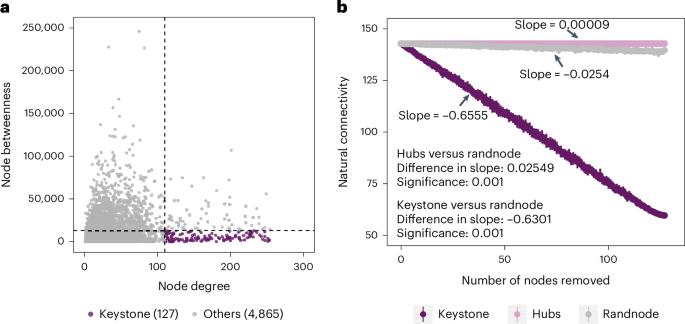Keystone taxa mediate the trade-off between microbial community stability and performance in activated sludges
IF 24.1
引用次数: 0
Abstract
Microbial communities form complex interaction networks where species cooperation is crucial for maintaining stability and performance. However, the key species and their specific roles in maintaining these properties remain poorly understood. Here, to address this, we conducted a large-scale network analysis of microbial communities in 1,186 activated sludge samples worldwide. The resulting activated sludge co-occurrence network exhibited a typical scale-free structure, with most taxa having few connections and a select few being highly interconnected. A group of keystone taxa, distinguished by high connectivity and a critical role in network stability, was identified. Microbial communities harbouring keystone taxa were more stable but exhibited lower pollutant removal rates. Comparative analysis showed that, in response to industrial wastewater inflow, communities with keystone taxa maintained more stable composition and species abundance while achieving similar pollutant removal rates. These results demonstrate that, while keystone taxa are critical for microbial community stability, this stability comes at the cost of reduced function in activated sludge systems. This study provides deeper insights into the link between community composition, stability and function, highlighting the potential to optimize microbial performance by manipulating keystone taxa. A large-scale network analysis of the microbial communities residing in nearly 1,186 activated sludge samples demonstrates an interplay between network stability and pollutant degradation, leveraged mainly by a group of keystone taxa.

关键类群在活性污泥中调节微生物群落稳定性和性能之间的权衡
微生物群落形成复杂的相互作用网络,其中物种合作对维持稳定性和性能至关重要。然而,关键物种及其在维持这些特性中的具体作用仍然知之甚少。在这里,为了解决这个问题,我们对全球1186个活性污泥样本的微生物群落进行了大规模的网络分析。所得到的活性污泥共生网络表现出典型的无标度结构,大多数类群之间的连接很少,而少数类群之间的连接程度很高。发现了一组具有高连通性和在网络稳定性中起关键作用的关键类群。关键类群所在的微生物群落较为稳定,但对污染物的去除率较低。对比分析表明,在工业废水流入的影响下,具有关键类群的群落在污染物去除率相近的同时保持了更稳定的组成和物种丰度。这些结果表明,虽然关键分类群对微生物群落的稳定性至关重要,但这种稳定性是以活性污泥系统功能降低为代价的。该研究为群落组成、稳定性和功能之间的联系提供了更深入的见解,突出了通过操纵关键分类群来优化微生物性能的潜力。对居住在近1186个活性污泥样本中的微生物群落进行的大规模网络分析表明,网络稳定性与污染物降解之间存在相互作用,主要由一组关键分类群发挥作用。
本文章由计算机程序翻译,如有差异,请以英文原文为准。
求助全文
约1分钟内获得全文
求助全文

 求助内容:
求助内容: 应助结果提醒方式:
应助结果提醒方式:


